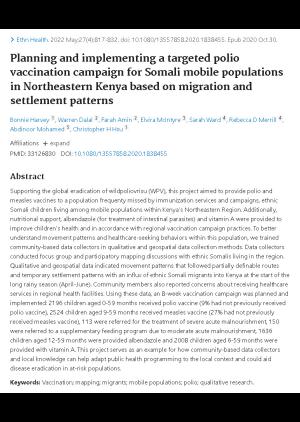Abstract
Supporting the global eradication of wildpoliovrisu (WPV), this project aimed to provide polio and measles vaccines to a population frequenty missed by immunization services and campaigns, ethnic Somali children living among mobile populations within Kenya's Northeastern Region. Additionally, nutritional support, albendazole (for treatment of intestinal parasites) and vitamin A were provided to improve children's health and in accordance with regional vaccination campaign practices. To better understand movement patterns and healthcare-seeking behaviors within this population, we trained community-based data collectors in qualitative and geospatial data collection methods. Data collectors conducted focus group and participatory mapping discussions with ethnic Somalis living in the region. Qualitative and geospatial data indicated movement patterns that followed partially definable routes and temporary settlement patterns with an influx of ethnic Somali migrants into Kenya at the start of the long rainy season (April-June). Community members also reported concerns about receiving healthcare services in regional health facilities. Using these data, an 8-week vaccination campaign was planned and implemented: 2196 children aged 0-59 months received polio vaccine (9% had not previously received polio vaccine), 2524 children aged 9-59 months received measles vaccine (27% had not previously received measles vaccine), 113 were referred for the treatment of severe acute malnourishment, 150 were referred to a supplementary feeding program due to moderate acute malnourishment, 1636 children aged 12-59 months were provided albendazole and 2008 children aged 6-59 months were provided with vitamin A. This project serves as an example for how community-based data collectors and local knowledge can help adapt public health programming to the local context and could aid disease eradication in at-risk populations.

Planning and implementing a targeted polio vaccination campaign for Somali mobile populations in Northeastern Kenya based on migration and settlement patterns
Author/s: Bonnie Harveya, Warren Dalal, Farah Amin, Elvira McIntyre, Sarah Ward, Rebecca D. Merrill, Abdinoor Mohamed, Christopher H. Hsu
Year:
Language: English
Publication Type: Scientific Report (Journal)(External)
Download this Publication
Year:
Language: English
Publication Type: Scientific Report (Journal)(External)
Download this Publication
Description
Region/Country (by coverage)
Publisher
Ethnicity & Health
Project Type